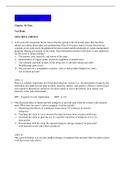Exam (elaborations)
Exam (elaborations) Nursing Theory III (NURS 1385) test bank 2020
- Institution
- Niagara University
Exam (elaborations) Nursing Theory III (NURS 1385) A 45-year-old woman has breast cancer that has spread to her liver and spine. She has been taking oxycodone (Percodan) and amitriptyline (Elavil) for pain control at home but now has constant severe pain and is hospitalized for pain control and dev...
[Show more]



